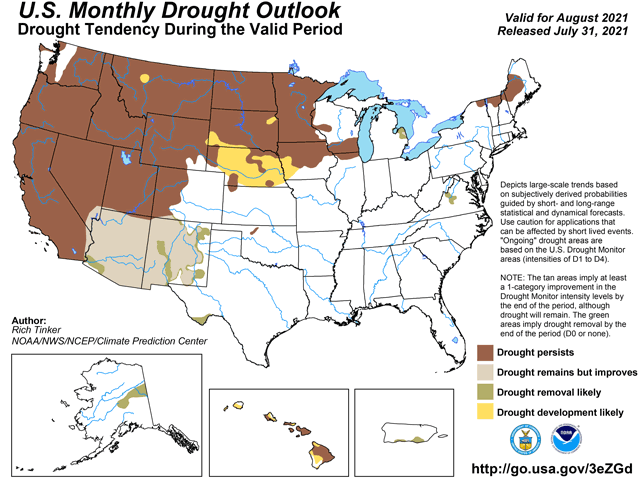NOAA: Drought to Expand
Drought to Expand Into Central Plains in August, Could Affect Yield Prospects, Frost Dates
Forecasts call for the north-central U.S. drought to expand into the Central Plains in August, according to a recent NOAA webinar. Crop conditions are likely to reflect this difference -- generally better east and worse west.
The NOAA Central Region Climate Services division presented the special drought situation and outlook webinar in early August. Dennis Todey, director of the USDA Midwest Climate Hub in Ames, Iowa, was the presenter.
Other highlights of the webinar included the August outlook, which calls for a continuation of the overall pattern of the 2021 crop season. No major changes are expected. August is showing a warmer trend across the entire central U.S. Precipitation remains drier in the outlook for Western areas (west of the Mississippi River). Eastern areas have heavier precipitation and better conditions overall.
Following are selected questions from the webinar attendees and a transcription of Todey's answers. Yield prospects and possible frost date impact are featured.
**
Q: How confident are you that corn and soybean yield (nationally) will reach trendline this season?
P[L1] D[0x0] M[300x250] OOP[F] ADUNIT[] T[]
TODEY: I'm not a yield forecaster. From Iowa east ... conditions are pretty good, so we're going to have at least trendline yields there and maybe slightly above. We're going to be losing yield in that northwest area -- which is a not insignificant area (Minnesota, North Dakota, South Dakota). I'm not confident at all about trendline yield (overall) but how far below trendline ... I'm not stepping out (to predict) because there's still a lot to determine.
Q: Has the most stressful period for corn already passed?
TODEY: The peak period for yield reduction in corn is around the tasseling period ... Newer (seed corn) varieties do better at dealing with drought, although if you have extreme drought, it's still going to cut into yields. The ability to add some yield potential goes on through the dough-filling stage in August. It's not as much as tasseling ... We still have the chance to make up some yield or lose more as time goes on. We still have time to gain or lose yield in corn. The window for soybeans is much bigger to either gain or lose yield.
Q: If drought persists into the fall, how does this set up for soil moisture recharge going into the 2022 crop season?
TODEY: That's the main question. There is a shift that occurs in the climatological pattern between seasons. We shift from our summertime pattern to a fall pattern, where we get more big areas of low pressure and high pressure. And those big areas of low pressure tend to produce wider-spread areas of low-intensity precipitation ... Those are particularly beneficial in getting water back on the landscape, because they're lower intensity, day or two-(day) rainfalls, you get a lot of infiltration into the soil, and you're not using up very much of that. So that gives us a better chance to improve our soil moisture conditions. We need to have that, particularly this year because of the very dry conditions in the Northern Plains, Minnesota, Iowa. So, we expect that to happen, although there's a slightly decreased chance of that happening this year. It's a concern for us, and it does set us up for problems next year if you don't get soil moisture recharge.
Q: How much of an impact will the dry soils have on the possibility of an early frost?
TODEY: Part of that depends on our moisture situation. If we can get a return of some moisture to the air, that could help delay some of our frost potential ... When you have very dry air, very dry conditions, you can cool down a bit more quickly at night and maybe, instead of getting down to 35 or 34 (degrees Fahrenheit), you get down to 31 or 30 degrees and then get into some frost or freeze situations ... The dry conditions are a potential risk because the soils are dry ... If crops dry down sooner, they're not transpiring as much moisture. So, it could be a risk, but if crops are mainly past their potential for damage, there may not be much of a risk overall.
Q: Will drought areas definitely be below trendline on yield?
TODEY: It's going to be below trend. Soybeans have time to recover. Corn will be below trend. I won't even venture a guess. I don't see any way that it's near or above trendline. Soybeans may still do better, but I'm not optimistic about soybeans either.
A recording of the entire webinar is available at this link: https://www.youtube.com/….
Bryce Anderson can be reached at bryce.anderson@dtn.com
Follow him on Twitter @BAndersonDTN
(c) Copyright 2021 DTN, LLC. All rights reserved.




